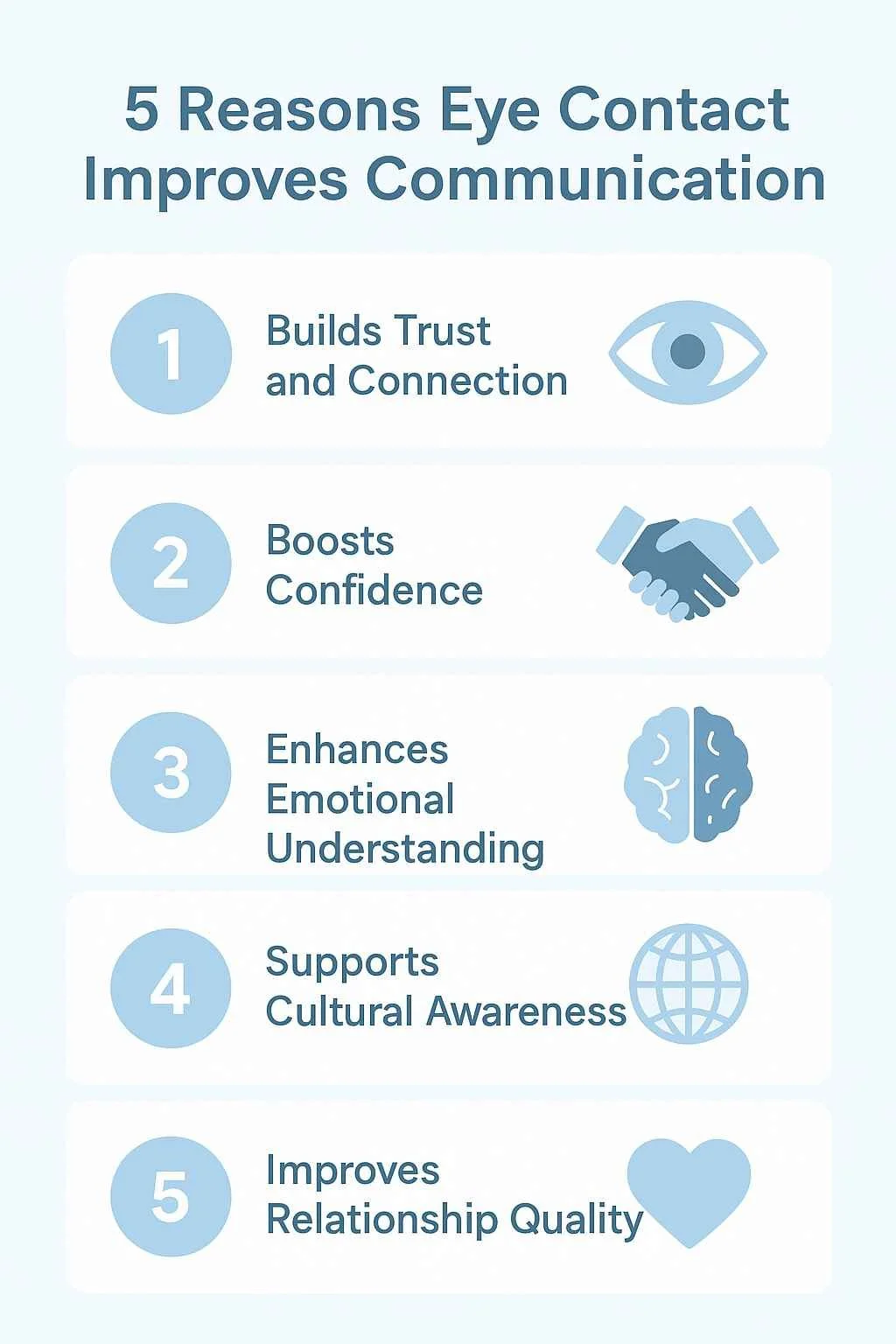Why Eye Contact Is Important for Communication Skills
Eye contact is often one of the first things people notice during a conversation. It can help us feel connected, demonstrate attention, and build trust. At the same time, maintaining eye contact can feel challenging in stressful or unfamiliar situations, and everyone’s comfort level is different.
Eye contact plays a vital role in nonverbal communication, but it is just one of many ways people express themselves. A direct gaze can convey focus and confidence, while occasionally looking away or using other nonverbal cues, such as facial expressions and hand movements, can also show engagement.
For some people, especially those with social anxiety or who come from cultures with different norms around appropriate eye contact, it may feel overwhelming or even uncomfortable. Recognizing these differences allows for more compassionate and effective communication.
Learning to use eye contact in communication in a way that feels natural can support personal growth and strengthen both personal and professional relationships. What matters most is finding a balance that feels authentic to you while still helping others feel heard and valued.
Key Takeaways
Eye contact can help build trust and understanding between people, but it’s not the only way to connect. Other nonverbal communication cues also play key roles, such as body language.
Maintaining eye contact in a way that feels comfortable can support self-confidence and show interest in the other person.
Too much eye contact or avoiding eye contact may be interpreted differently depending on the situation and culture. Flexibility helps conversations feel more natural.
Cultural differences and individual experiences shape how people use eye contact. Being aware of these differences shows respect and supports stronger connections.
The Role of Eye Contact in Communication Skills
Cultural Differences in Eye Contact in Communication
Building Comfort with Eye Contact in Communication
Why Eye Contact Is Important for Building Relationships
The Role of Eye Contact in Communication Skills
Eye contact is often described as a key part of nonverbal communication, but its role varies from person to person. In many situations, maintaining eye contact may signal confidence, honesty, or respect. In others, especially across different cultures or for people with unique communication styles, direct eye contact may feel uncomfortable or even inappropriate.
How Eye Contact Communication Affects Overall Communication Skills
Eye contact in communication can shape how messages are both expressed and interpreted. It may signal focus, interest, or emotional connection, while also helping people notice other nonverbal signals.
Direct eye contact can convey presence and confidence.
Breaking eye contact may show thoughtfulness or reflection.
Avoiding eye contact can reflect many things, such as comfort levels, cultural norms, or neurodivergent communication styles.
In settings like job interviews, eye contact may help convey attention and self-confidence. In everyday conversations with friends or family, a shared gaze can convey warmth or care.
The Science of Eye Contact and Nonverbal Communication
Research suggests that making eye contact activates parts of the human brain responsible for emotional awareness and empathy. These areas respond to direct gaze, helping people recognize others’ emotional states. Other primates use gaze to communicate, but humans depend on it far more in complex communication.
Studies indicate that holding eye contact for a few seconds often feels comfortable, while prolonged eye contact may seem intense. Short glances, on the other hand, can suggest thoughtfulness or allow space for reflection.
There isn’t a single “right” amount. Comfort levels vary across people, cultures, and contexts.
Eye Contact Skills and Other Nonverbal Cues
Eye contact is most effective when combined with other nonverbal communication strategies such as facial expressions, hand movements, and tone of voice. Together, these signals help listeners interpret tone and emotion. A warm smile and a direct gaze can convey openness, while a lack of expression can make someone appear distant.
Avoiding someone’s eyes may make others misread your feelings or intentions. Eye movements can also show thinking patterns, such as looking up while recalling information. By becoming aware of both eye contact skills and other nonverbal cues, we can better understand one another and build stronger, more respectful communication.
Cultural Differences in Eye Contact in Communication
Appropriate eye contact looks different across cultures. In many Western countries, direct eye contact is often associated with respect and honesty. In other regions, however, prolonged or constant eye contact may feel uncomfortable, confrontational, or less appropriate.
Being aware of these cultural differences can reduce misunderstandings and support smoother communication. For example, in some Asian cultures, lowering the eyes with authority figures may signal politeness, while in many North American contexts, maintaining eye contact can be seen as a sign of confidence.
Understanding and respecting these differences helps people connect more meaningfully across diverse backgrounds.
Conversation Coach
Check out our blog on how to boost your communication skills with a conversation coach.
Building Comfort with Eye Contact in Communication
Modifying your comfort with eye contact in communication takes time, patience, and self-awareness. Small, gradual steps can make the process feel more natural in real-life situations, from conversations with friends and family members to job interviews and daily social interactions.
Start with supportive settings. Practice keeping eye contact for a few seconds in relaxed conversations with trusted friends or family members. Focusing on the other person’s eyes helps build awareness without putting pressure on either person.
Use gradual exposure. Increase the duration and expand the settings step by step, moving from casual conversations to professional environments, so progress feels manageable.
Shift your focus. Looking near someone’s eyes instead of directly locking eyes can reduce pressure and still show engagement.
Break eye contact naturally. Briefly looking away signals reflection and helps keep the interaction comfortable for both people.
The importance of eye contact is not about achieving perfection but about finding what feels authentic. It can sometimes feel awkward, yet practicing these skills offers many benefits. Eye contact can help a person appear more self-assured and support conveying emotions more clearly.
For those who find eye contact particularly difficult, seeking support from a coach or therapist can provide guidance and encouragement for overcoming challenges. Over time, paying attention to both eye contact skills and other nonverbal cues strengthens confidence, connection, and clarity in communication.
Why Eye Contact Is Important for Building Relationships
Eye contact plays a vital role in building relationships because it signals interest, respect, and trust. It shows presence, attention, and empathy, which strengthen both personal and professional bonds. People tend to feel more valued when someone maintains consistent eye contact during conversation.
In personal relationships, maintaining eye contact can show affection and connection. In workplaces, it may support teamwork, leadership, and cooperation. Practicing effective eye contact may help convey confidence and emotional understanding across all types of social interactions.
Frequently Asked Questions About Eye Contact
1. What does eye contact signify in communication?
Eye contact often signals attention, interest, and connection. Many people interpret it as a sign of confidence and respect, though its meaning can vary by culture and individual communication style. It is one way, among others, to show engagement in a conversation.
2. How can I practice eye contact if I feel uncomfortable?
Start in low-pressure situations and build gradually. Try looking toward a person’s eyes for just a few seconds during relaxed conversations, then extend the time as it feels more natural. Practicing in supportive settings helps increase comfort and ease.
3. How much eye contact is considered appropriate?
There is no single rule for the “right” amount of eye contact. Research suggests that three to five seconds often feels comfortable for many people, but preferences differ across individuals and cultures. The most important factor is adjusting based on what feels respectful to both you and the other person.
4. Why do some people avoid eye contact?
Avoiding eye contact can reflect a range of factors, including cultural traditions, social anxiety, shyness, or personal comfort. In some settings, it may even be a sign of politeness. Rather than assuming disinterest, consider the broader context and other nonverbal cues.
5. Can maintaining eye contact help in job interviews?
Balanced eye contact in job interviews can show attentiveness and professionalism. It may also help you appear confident and engaged. At the same time, your tone of voice, body language, and thoughtful responses all contribute to making a strong impression.
How Connected Speech Pathology Can Help
Connected Speech Pathology provides online speech therapy and communication coaching for adults who want to feel more comfortable with eye contact in communication. Our speech-language pathologists and professional coaches support clients in developing strategies that fit their individual needs and communication styles.
Sessions may focus on building self-awareness, practicing supportive conversations, engaging in joint attention activities, and using techniques to reduce anxiety in real-life situations. Clients explore how to use eye contact naturally in contexts like meetings, job interviews, and social interactions, while also paying attention to other important nonverbal cues.
Our approach is flexible and person-centered, helping you increase confidence, feel more at ease in conversations, and strengthen overall communication skills.
Summary
Eye contact plays an important role in effective communication by helping people connect, express emotions, and build trust. It can signal attentiveness and respect while adding depth to spoken words. Understanding what feels natural for you supports comfort and confidence in conversation.
With practice, reflection, and increased self-awareness, people can expand their comfort with maintaining eye contact. These skills can enhance relationships, strengthen communication, and support greater confidence in both personal and professional settings.
About the Author
Allison Geller is a communication coach, speech-language pathologist, and founder of Connected Speech Pathology, an international online practice providing professional communication coaching and speech therapy for children, teens, and adults. With more than two decades of experience, she has worked in medical and educational settings, published research on aphasia, and leads a team of specialists helping clients improve skills in public speaking, vocal presence, accent clarity, articulation, language, fluency, and interpersonal communication.









